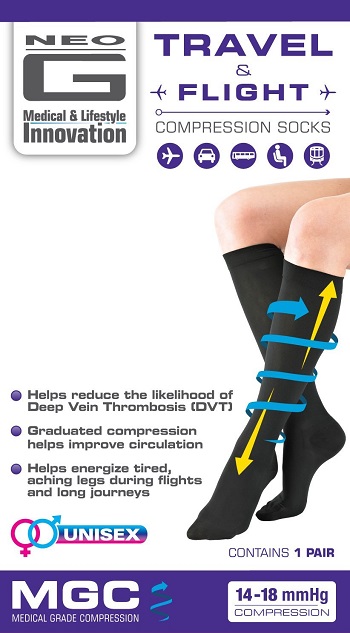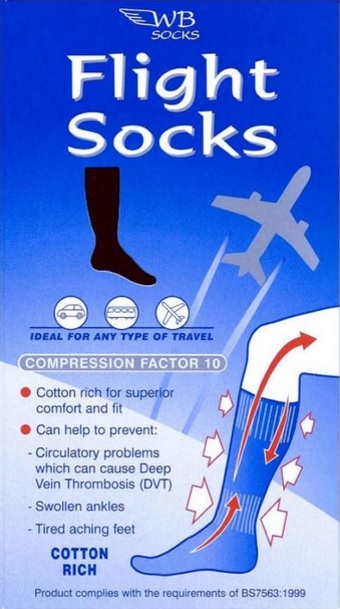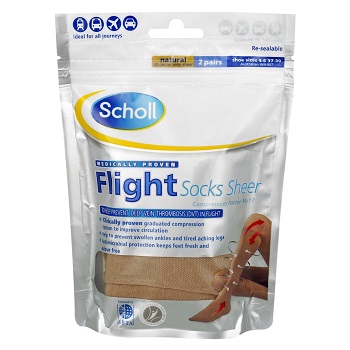Table of Contents
- Our top recommendations: Best flight socks
- What is Deep Vein Thrombosis?
- What is travel-related deep vein thrombosis?
- What are the symptoms of DVT?
- What to do before travel
- What to do during journey
- How to get the right size flight socks
- How long can you wear flight socks for?
- How tight should flight socks be?
Our top recommendations: Best flight socks
Research has revealed that wearing flight socks can reduce the chances of deep vein thrombosis by more than 90%. Airline passengers can anticipate a considerable reduction in the risk of DVT if they wear compression socks. To ease your search, we sampled the best flight socks to encourage healthy blood flow and prevent clotting.
1. Neo G Travel & Flight Compression Socks
Designed primarily to help improve circulation on long journeys, the Neo G travel & flight compression socks feature a shaped heel cup for perfect positioning, top band for comfortable fit and reinforced toe for durability and comfort. The socks have a graduated compression of 14-18mmHg with maximum firmness at the ankle that decreases gradually up the leg. They are unisex and discreet and are ideal for all types of travel.
2. Cotton Rich Anti-DVT Flight Socks
With cotton-rich anti-DVT flight socks, you are assured of firm 10mmHG ankle support and graduated compression throughout. Each pair is made of 68% cotton for comfort with 29% nylon and 3% elastane for support. It is available in a variety of sizes and can be worn by anyone regardless of gender and age. Additionally, they conform to British quality standards and are ideal for all types of long distance travel.
3. Scholl Flight Socks
These socks are medically proven to help prevent DVT by helping to improve circulation. Primarily made from fibre content, they are ultra-soft and have a comfort top. Beyond the sorts, they look and feel like regular socks. Moreover, they have antimicrobial protection to keep your feet fresh and odour free throughout the journey. Their compression level is 14-17 mmHg graduated all the way up to the knee. Scholl Flight socks are recognised by ABTA and approved by Aviation Health Institute.
What is Deep Vein Thrombosis?
Deep vein thrombosis is a blood clot that forms in a deep vein located within the body. A blood clot is a small mass of blood that in solid state. Blood clots typically form in your thigh or leg, but they can also develop in other parts of your body. DVT occurs most commonly in people over 40 years of age. Certain conditions that alter the movement of blood through the veins can also increase your risk of developing clots. They include history of DVT, recent surgery, cancer, stroke, being overweight, having an injury or smoking.
If you are travelling to long distance places by plane, car or bus, you are at a slightly higher risk of developing DVT. This is due to long hours of sitting immobile and cramped. Blood flows slowly and may collect in the legs as they are hanging down. As such, clot formation is more likely to happen.
What are the symptoms of DVT?
- Pain, swelling and tenderness in the affected leg. Rarely, you may experience swelling in both legs.
- Severe cramping that usually begins at the calf of the affected leg.
- Skin over the affected area gets warmer than the surrounding skin.
- Skin over the affected area turns pale or bluish in colour.
DVT may at times occur without any noticeable symptoms. However, common warning signs include sudden shortness of breath, light-headedness and rapid pulse.
What to do before travel
If you think you are at a slightly high risk of developing DVT, consult your GP before travel. Your doctor might prescribe medications that will thin your blood and make it harder for clots to form. Likewise, wearing compression socks applies gentle pressure to the ankle and boosts blood flow.
It’s, however, important that compression socks be measured beforehand. They come in a variety of sizes and have different levels of compression. For instance, class 1 socks with a pressure between 14-17mmHG are generally sufficient. Wearing ill-fitting socks could increase the risk of DVT. Seek advice on fitting from a healthcare professional.
What to do during journey
While travelling long distance, especially on a long haul plane:
- Make sure you have enough room in front of you for your legs to move.
- Every hour or so, bend and stretch your legs when seated.
- Take a walk up and down whenever you can.
- Consider wearing flight socks or a foot hammock if you have space.
- Drink plenty of fluids.
- Avoid taking alcohol and sleeping pills.
How to get the right size flight socks
Take leg measurements before you buy compression socks for a flight. Compression socks that are too long or too short can negatively affect blood circulation and even increase the risk of deep vein thrombosis.
To measure properly, ask a friend to take the measurements so that you can stand straight. Make sure you are barefoot and are not wearing socks or pants when you take measurements.
If there isn’t someone to measure you, sit on a chair and place your feet flat on the ground and your legs at a 90-degree angle.
- For your ankle, measure the circumference at the narrowest point just above the ankle bone. This ensures the socks apply sufficient compression on the lower part of your leg to boost circulation.
- For your calf, measure the circumference at the widest point. That’s because you don’t want the socks compressing your leg too much at this point. They should fit snugly without being too tight.
If you are getting thigh-high flight socks, measure your thigh as well. Measure the circumference at the widest point of your thigh.
Next, take height measurements.
For knee-length socks, measure from the floor to the back of the knee. Make sure you stand upright and your foot is flat on the floor.
For thigh-high socks, measure from the floor to the gluteal fold, the crease where your buttocks meet your upper thighs.
Use these measurements to find the right size of flight socks. Most sellers provide a detailed measurement table you can use to choose the correct size.
How long can you wear flight socks for?
Wear flight socks during the entire duration of the flight then take them off when you get reach home or your hotel room.
How tight should flight socks be?
Flight socks should be snug but not uncomfortably tight. They should feel snugger around the ankles and less snug around your calves, what’s referred to as graduated compresison.
Make sure you take the right measurements before buying flight socks. This will allow you to choose the right fit for your legs.
Also, check the pressure rating of the socks. For flight socks, medium compression socks with a pressure of 15-20 mmHg are ideal for most travelers.
Note: It is recommended that you seek medical advice before getting yourself compression socks if you have any of the the aforementioned medical conditions.








For a little while, getting this vein thing was one of the reasons I was scared to go on an airplane. Even with the socks I am still not sure that I would get onto a long plane ride.